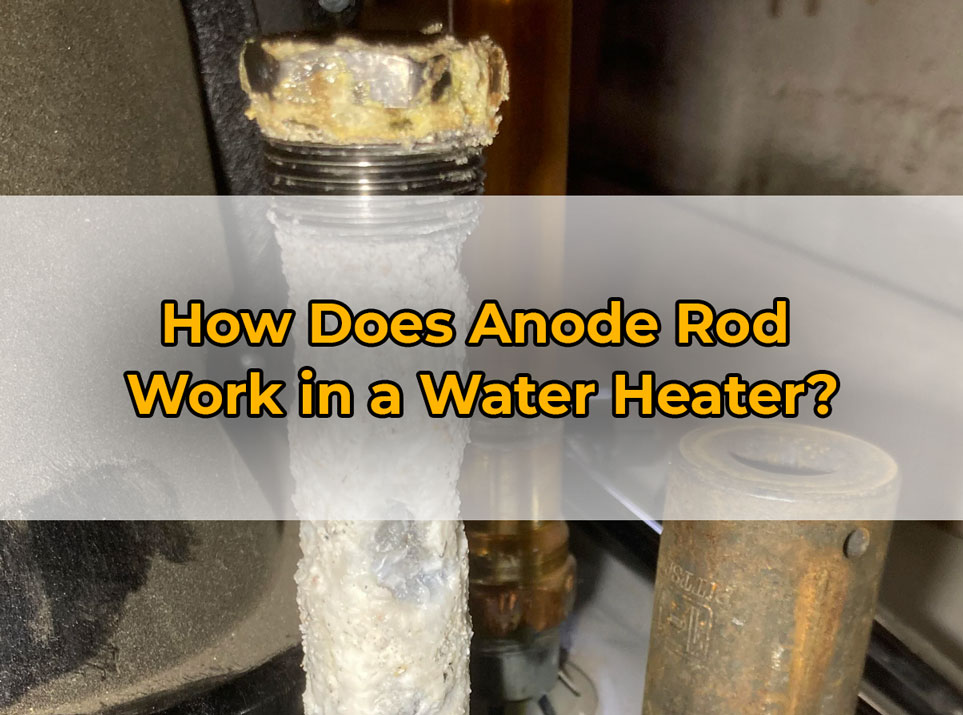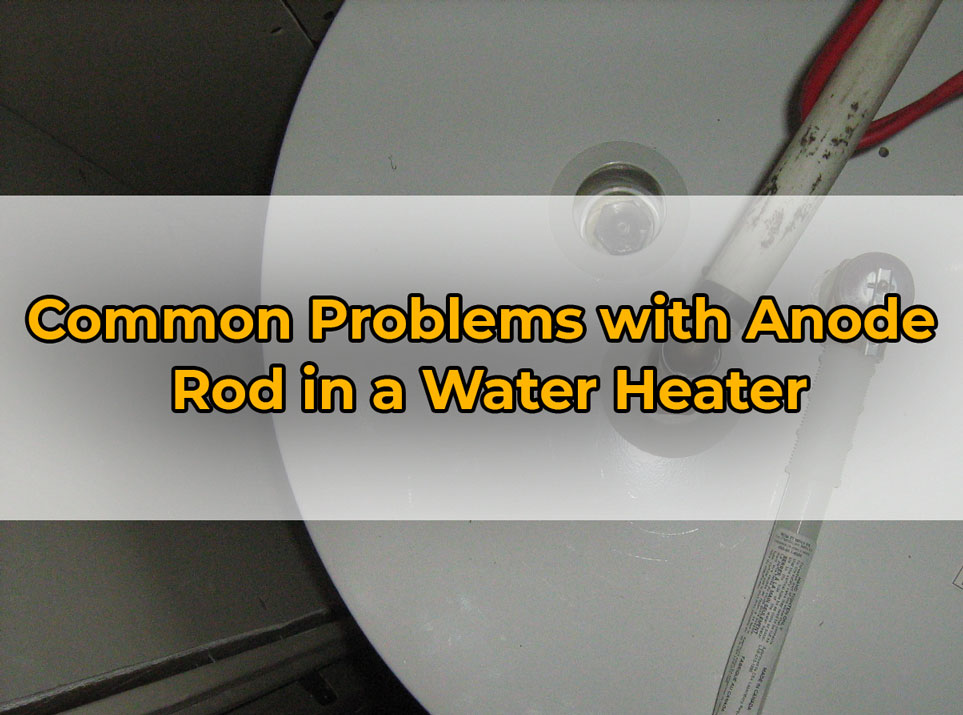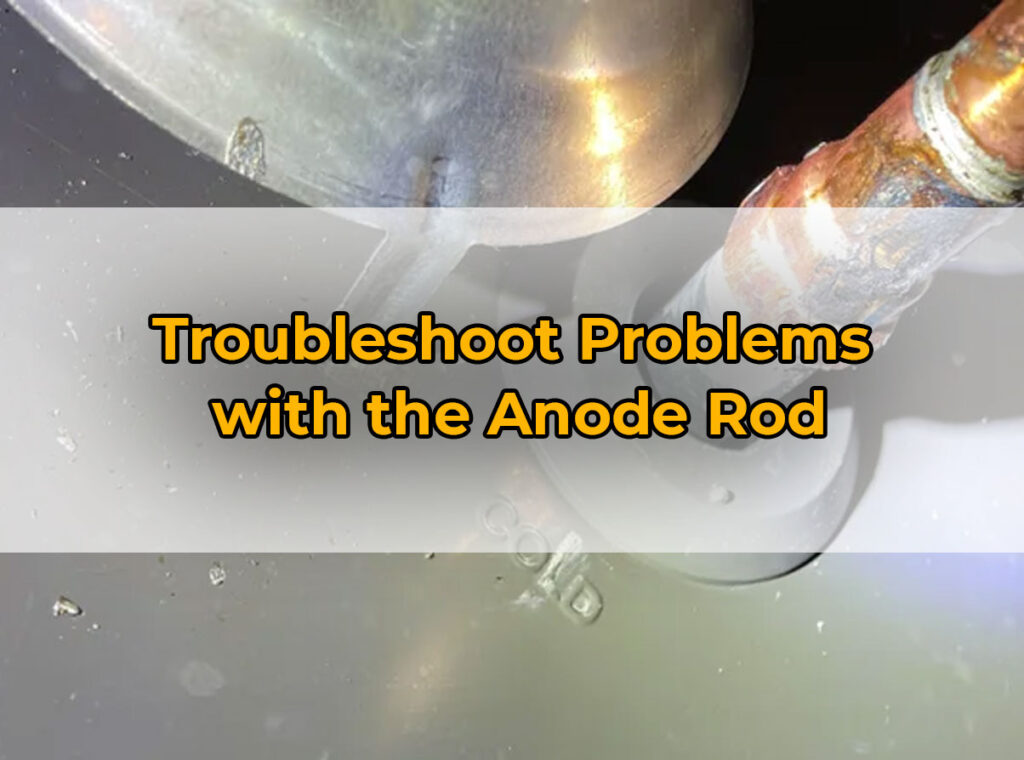An anode rod water heater is a key component of water heaters in homes and commercial buildings. It works by drawing in corrosive substances from the water, shielding the tank’s lining and enhancing its life.
Sometimes, homeowners may have issues such as stinky water or leaking, despite regular maintenance of their water heaters. This could mean the old anode rod needs to be replaced. Don’t forget to inspect your anode rod often!
Remember, anode rods act like guards for your tank, keeping the bad stuff out.
Here are more detailed explanation on anode rod water heater!
How Does Anode Rod Work in a Water Heater?

Anode rods are a crucial component of water heaters that prevent corrosion and extend the lifespan of the tank.
The anode rod water heater works by attracting corrosive particles in the water, which then corrode the anode rod instead of damaging the tank’s interior.
| Types of Metals | How the Rod Works | When to Replace |
|---|---|---|
| Aluminum | Attracts corrosive particles in water to prevent tank corrosion | Rust-colored water or a sulfurous odor |
| Magnesium | Attracts corrosive particles in water to prevent tank corrosion | Rust-colored water or a sulfurous odor |
1. Overview of an Anode Rod
An anode rod water heater is essential for the long life of your water heater. It attracts corrosive elements, shielding the tank from them and thus lengthening its lifespan.
The anode rod material is either magnesium or aluminum alloy and it’s placed either at the top or in the middle of the tank.
It’s important to remember that, eventually, the anode rod will corrode and need replacing. Ignoring this may lead to sediment and leaks in your water heater. To ensure peak performance, check it once a year and replace if needed.
Also, upgrade to a powered anode rod for continuous protection. And don’t forget regular maintenance and Flush Water Heater for additional protection. Anode rod: a sacrificial lamb, willingly dissolving for the betterment of your water heater.
It’s important to note that anode rods vary based on the type of water heater and the geographic location. For example, a water heater in a coastal area may require a different type of anode rod due to the high salt content in the water.
2. Mechanism of Action of Anode Rod
Anode Rods are essential in a water heater. They help avoid rust and deterioration of the tank’s inner lining by attracting ions. Magnesium or Aluminum is used and suspended on top of the water via a metal core.
A sacrificial oxidation reaction takes place between the metal in the anode and minerals in the water. This creates cathodic protection which stops corrosive elements from affecting the steel-made water tank.
Temperature changes can affect the lifespan of an anode rod. To make your water heater last longer, understanding the importance of anode rods is key!
3. Importance of Anode Rod in a Water Heater
Anode Rods in Water Heaters – Protecting Your Investment!
Understanding the importance of anode rods is key to ensuring water heaters work efficiently and last for years. These sacrificial metal rods stop corrosion, which can cause leaks and harm other parts of the heater.
Hard water corrodes anodes quickly. In those areas, inspections and replacements should be more frequent. Not looking after anode rods can lead to expensive damage to your home. It’s essential to know how they work and why they’re important.
A study by IAPMO revealed that over 75% of water heater failures result from corrosion. Therefore, it’s critical to make sure anode rod water heater are fine and replaced as indicated by manufacturers. An anode rod that doesn’t work has no power – it’s useless.
Common Problems with Anode Rod in a Water Heater

Have you been facing issues with the anode rod in your water heater? We will discuss some common problems that occur with the anode rod in a water heater and how to troubleshoot them. Check also: fixing water heater pilot light.
Some of the common problems with the anode rod in a water heater are:
1. Corrosion of Anode Rod
The anode rod gradually corrodes, as it sacrifices itself to protect the tank interior from rusting. Corrosion rate varies based on water hardness and usage frequency. Aluminum and magnesium, both anode rod materials, react differently to water chemistry. Hard water corrodes aluminum more, while soft water corrodes magnesium quicker.
Replacing the anode rod regularly can prolong your unit’s life. But, neglecting it can result in rust and leaks within the tank. Foul odors and discolored water from faucets, could be a sign of a corroded rod that needs replacing.
2. Reduced Efficiency of the Anode Rod
The Anode Rod of a Water Heater – Performance Declining?
Is your anode rod’s performance declining? This is common when the water supplied to the water heater is of low quality. When the water hardness or mineral content increases, metal ions and hydrogen join forces to create hydrogen sulfide gas. This gas can cause clogging and reduce anode performance.
It’s essential to inspect, clean, or replace your anode rod regularly to prevent corrosion-related damage. Specialized tools for cleaning pool equipment and pipes should be used.
If you notice rapid corrosion on your anode rod surface, there are various options available. Try thermal cure-processes, which heat and dry out pellets to fix technical inconsistencies. Alternatively, heating elements in vacuum chambers can be used for Pellet Chlorination treatments.
3. Bacterial Growth Yields a Bad Smell
Microbial Activity results in unpleasant odors. Bacteria in a water heater tank can cause an odor from hot water. Low flow or low temperature cause bacterial growth. Corroded anode rods release hydrogen sulfide, which encourages bacteria. This leads to a bad smell.
Many homeowners neglect tankless water heater maintenance , creating germs. To stop the smell, clean & replace the anode rod every 5 years. Install a chlorine-infused rod to kill bacteria. Be careful when cleaning the tank, don’t damage pipes and valves.
Care for the water heater: long life + safety. Handle anode rod problems with ease!
How to Troubleshoot Problems with the Anode Rod

An anode rod water heater is an essential component of a water heater that prevents the tank from rusting. To maintain its efficiency, it is crucial to troubleshoot any problems that may arise. Here’s how you can troubleshoot problems with the Anode Rod:
1. Inspecting the Anode Rod
To inspect your sacrificial anode rod:
- First, switch off your water heater’s power source.
- Then, carefully loosen the anode rod. Make sure you leave enough room for it to move when you unscrew it from the tank.
- Examine if there are any signs of corrosion or damage that have revealed the metal core. Replace it if more than half of its diameter is eroded.
We suggest checking the core material’s zinc quantity instead of straight-out replacing magnesium ones if they are half-eroded. This helps your system run optimally. Keep in mind that inspecting the Anode Rod could reveal other issues with your hot water system.
If you live in an environment with faster erosion, consider replacing your water heater with one that has a superior quality anode rod. Heavier rods last longer and increase tank life.
By following these instructions, you can effectively diagnose and resolve problems with your Anode Rod and extend your water heater’s lifespan. Get scrubbing that anode rod until it sparkles!
2. Cleaning the Anode Rod
Cleaning the sacrificial anode rod is a must for keeping your water heater in good shape. Otherwise, you could face costly corrosion and other issues. Here’s a 5-step guide to get it done:
- Turn off the gas/power.
- Locate the anode rod (on top of the tank usually).
- Carefully remove the rod with a socket wrench and inspect it.
- Replace the rod if needed.
- Clean the surface of the rod with white vinegar, then reinsert it.
Check your manufacturer’s instructions first, as wrong cleaning methods can cause damage. Clean the anode rod every two years, or even every 6 months in areas with high mineral content.
Don’t forget to do this routine task! Give proper care to all the components of your home and protect it. Cleaning the anode rod is like giving your water heater a new lease on life!
3. Replacing the Anode Rod
Replace an anode rod water heater like a Pro!
Do you need to replace your anode rod? Here’s how:
- Turn off the power and water supply.
- Open the hot water tap to water heater Pressure Relief Valve.
- Locate the anode rod. It’s usually at the top of the tank, held by a screw or nut.
- Use a socket wrench to loosen the anode rod. If it’s stuck, use penetrating oil or heat.
- Insert the new anode rod and tighten it securely, making sure it’s straight, level, and not leaking.
- Turn on the water supply and fill up your tank.
- Restore power to your unit.
Replacing anode rods every 3-5 years can save your water heater. Magnesium rods are better in hard water conditions than aluminum rods, which can create pitting that shortens their life.
Anode rods were first used in ships during WWII. Harold Terry patented magnesium alloy in 1947 and created the first commercial product called Mag-Anodes. In 1979, it changed its name to TPI Corporation after merging with another company.
Check your anode rod regularly or else you’ll regret it later!
Conclusion
Anode Rod Water Heater: All You Need to Know.
The anode rod is key in protecting your water heater from corrosion. Over time, the rod wears down and this impacts efficiency. Thus, regular inspection and replacement are essential.
To troubleshoot, inspect the rod for wear. Replace it if it has corroded more than 6 inches. Listen out for strange noises or odors from the hot water supply.
A plumber can help identify any underlying issues. Make sure you get a compatible replacement that’s suited to your water heater type.
Replacing the anode rod water heater regularly boosts your heater’s lifespan and prevents breakdowns. Check also: How to Increase Water Pressure in Shower.
What are the symptoms of a bad anode rod in a water heater?
If you’re wondering what are the symptoms of a bad anode rod water heater , there are several signs to watch out for. First and foremost, if you notice that your hot water has an unusual odor or taste, this may be due to excess sediment buildup caused by corroding anode rods.
Another sign could be discolored or rusty looking hot water coming from your faucets; this often indicates that the inside of your tank is rusting and needs attention as soon as possible.
Can an anode rod be cleaned and reused?
If you’re wondering whether or not you can reuse your old anode rod after it has started to corrode, the short answer is no. Once an anode rod has worn down significantly, it needs to be replaced with a new one in order for your water heater to function properly. However, this doesn’t mean that you should just throw away your old anode rods without trying to clean them first.
How many anode rods are in a water heater?
The number of anode rods in a water heater varies depending on its size and type. Smaller tanks designed for residential use typically come with one anode rod, while larger commercial models may have up to four or more. In some cases, manufacturers offer optional second or third rods that can be added to water heater expansion tank as needed.
“There is no real ending. It’s just the place where you stop the story.”






